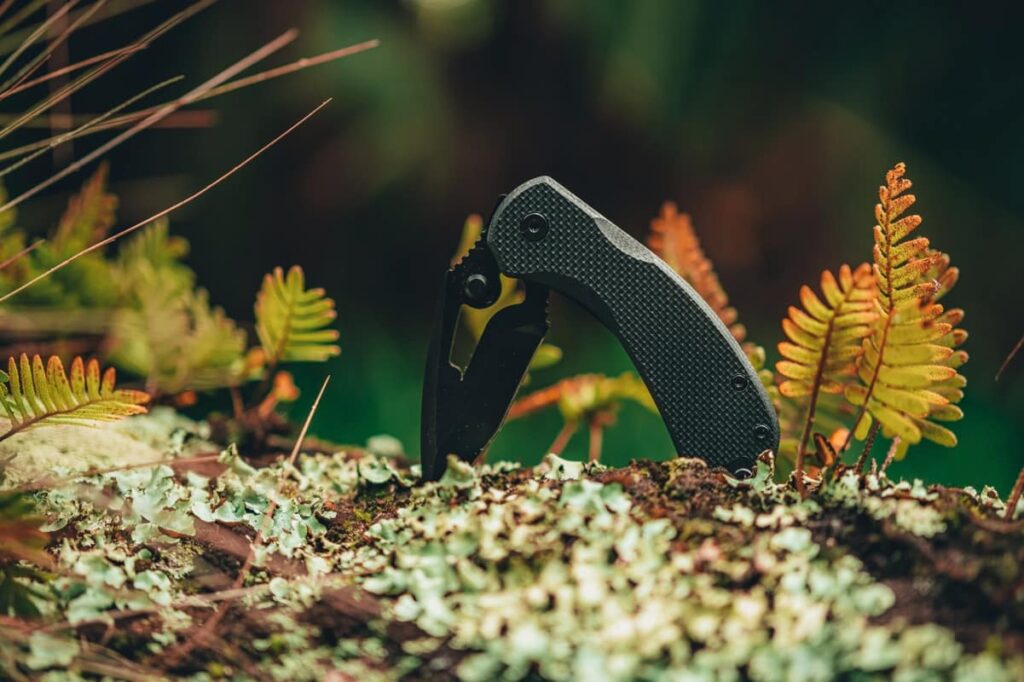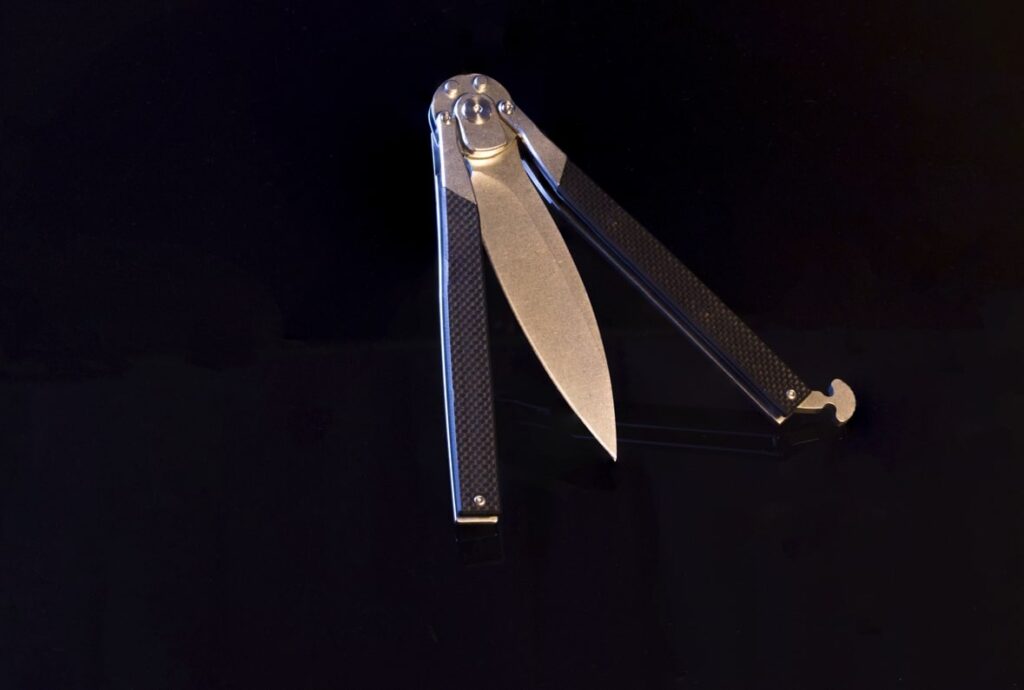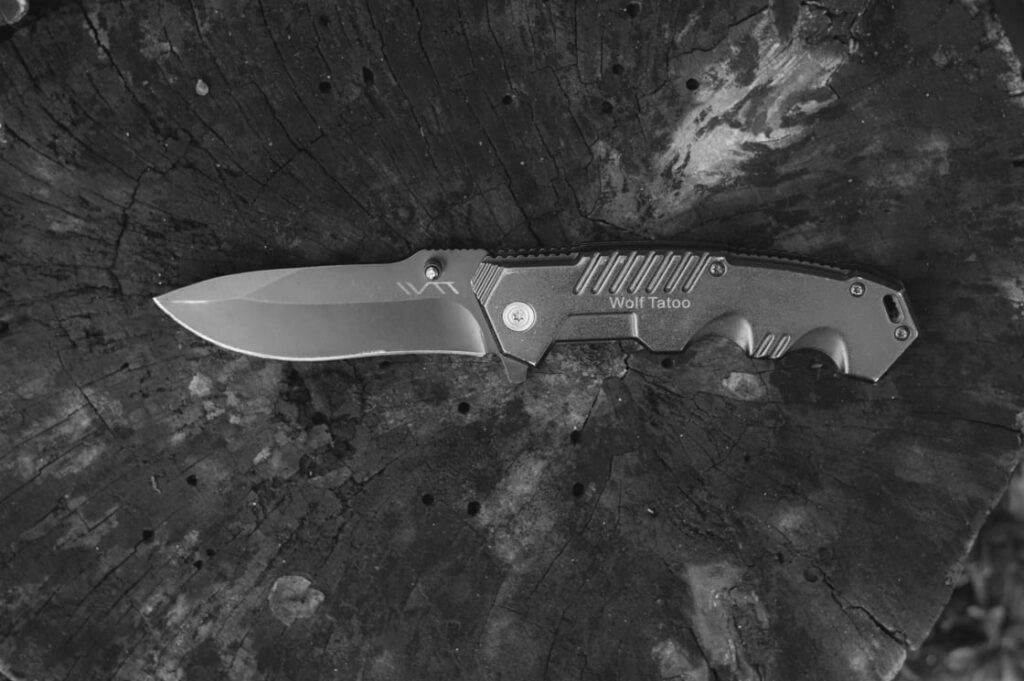A switchblade knife is a type of knife with a folding or sliding blade contained in the handle which is opened automatically by an opening mechanism, typically a spring or a switch. These knives are designed for quick deployment with one hand, which makes them distinct from other manually operated pocketknives or fixed blade knives (which you need to pull the blade out from a sheath).
When you handle a switchblade knife, you’re engaging with a mechanism that relies on a spring-loaded blade that locks into place once fully extended. A release mechanism is then used to close the knife. The design of switchblade knives can vary, with some models featuring a blade that shoots out from the front of the handle, while others may have a blade that swings out from the side.
Switchblade knives have a complex legal status; they are restricted or prohibited in many jurisdictions due to their association with concealment and rapid deployment for nefarious purposes. However, they are also used by individuals who require a knife that can be quickly deployed with one hand, such as military personnel, emergency responders, or people with limited hand mobility. It is important to be familiar with your local laws if you own, or are considering purchasing, a switchblade knife.
Development of switchblade knives
The invention of the switchblade dates back to the mid-18th century. You will find that these knives were first documented in Europe, with the earliest models being spring-operated blades from France and Italy. Initially, switchblade knives were luxury items tailored for the elite, crafted with expensive materials and intricate designs.
As you move through history, the 19th century saw considerable evolution in switchblade design. With the Industrial Revolution, mass production became feasible, making these knives more accessible to the common person. The typical switchblade started to feature a sliding or folding blade tucked in the handle which was released by a spring mechanism when a button or lever was activated.
The evolution of these knives was also influenced by military use, as they were convenient for parachutists who might need to cut shroud lines after landing.
The modern switchblade continues to be refined with advancements in materials and technology, resulting in more durable, reliable, and safer designs. Laws and regulations regarding switchblade knives have also changed over time, impacting their availability and modification.

What is a switchblade knife?
A switchblade knife refers to a folding knife with an automatic opening mechanism. It differs from a fixed blade pocket knife by featuring an opening mechanism. Also, unlike manual or assisted-opening folding knives, a switchblade employs an automatic mechanism for faster deployment of the blade.
Start Working with a Professional Now
As if all the knife names are not complicated enough, There are many sub-categories within the simple umbrella word “switchblade knife” as well. Some of the most common ones you can find on the internet include:
- Side opening: The blade smoothly pivots outward from the side of the handle, akin to the mechanism found in traditional pocket knives, offering a classic and practical approach to deployment.
- Out The Front (OTF): This design features a blade that slides parallel to the handle, extending straight out from the front. OTF knives are known for their swift and efficient deployment, making them popular among users seeking quick accessibility.
- Single action: In single-action switchblades, the blade is deployed with a press of the button, but manual retraction is required. This straightforward mechanism ensures simplicity in operation.
- Double action: Contrasting single-action, double-action switchblades not only deploy the blade with a button press but also retract it using the same mechanism. This dual functionality adds versatility and convenience to the knife’s operation.
- Butterfly knives: Also known as balisong knives, these feature a unique hinged handle that allows the blade to be concealed within the handle when closed. The distinctive flipping motion used to open and close butterfly knives requires skill and precision, making them a favorite among enthusiasts for their aesthetic and skill-oriented appeal.
Your switchblade may have additional features such as a safety mechanism to prevent accidental deployment, and a restraining pin or ramp that interfaces with the blade’s springs and pins to secure it when opened or closed.
Common openers and locks for switchblade knife
Switchblades are distinguished by their unique opening and locking mechanisms. Both features are essential to provide you with both quick deployment and safe handling.
Openers

Your switchblade may employ different systems to activate its blade. The most common method involves a press of a button which releases the blade housed within the handle under tension. The common openers include:
- Push button: Pressing a button on the handle activates a spring mechanism that rapidly deploys the blade. This is the classic and most well-known switchblade opening method.
- Coil spring: Similar to the push-button mechanism, a coil spring is compressed when the knife is closed and released when the button is pressed, causing the blade to quickly open.
- Butterfly: The blade is concealed within two handles that rotate around a pivot point. The user performs a flipping motion to open the knife. Balisong knives are often used for tricks and flipping maneuvers.
- Side-Opening lever (Swinguard): A lever on the side of the handle is manipulated to swing the blade open. This is common in Italian-style stiletto switchblades.
Locking mechanisms
Once your blade is extended, the locking mechanism ensures it remains in place during use. Here are the common types:
- Liner lock: A thin liner made of metal moves into place under the blade after it’s opened, preventing it from closing.
- Frame lock: Similar to liner lock but utilizes a section of the knife’s handle frame to lock the blade.
- Button lock: Often used in conjunction with the opening mechanism, a button releases the lock for you to retract the blade back into the handle safely.
Frame Lock vs. Liner Lock – An Comprehensive Guide
Your switchblade may include different combinations of these mechanisms, providing varying levels of safety and convenience depending on your needs.
Switchblade knife vs Assisted-Opening knife vs Manual knife
When you’re considering a pocket knife, the mechanism it uses to open can be a key differentiator. Here’s how switchblade, assisted-opening, and manual knives compare:
Switchblade knife: A switchblade, also known as an automatic knife, opens its blade at the press of a button or switch, usually located on the handle. This type of knife is designed for rapid deployment with one hand. However, due to its mechanism, switchblades are regulated or prohibited in many areas.
Assisted-Opening knife: This knife uses an internal mechanism to help you open the blade. Once you begin the process by pushing a thumb stud or flipping a lever, the mechanism takes over to fully extend the blade. These are generally legal as they require some manual effort to start the opening process.
Manual knife: Your most traditional choice, a manual knife requires you to fully open the blade using your hand with no mechanical assistance. Often, you’ll use a thumb stud, a nail nick, or simply the blade itself to open the knife. It requires practice to open quickly but is legal in most places.
Start Working with a Professional Now
Legal considerations
Before you consider owning or carrying a switchblade knife, it’s essential to be aware of the legal landscape which varies by jurisdiction and internationally. The differences in laws may affect the legality of possession, carry, and interstate commerce related to automatic knives.
State and local laws
In the United States, state laws governing switchblades are highly variable. For example, as of the current date:
- California: You may possess a switchblade with a blade length less than 2 inches.
- New York: Possession of a switchblade is generally illegal, regardless of blade length.
- Texas: You can legally carry a switchblade since the prohibition was repealed.
Local ordinances can also impact your rights. For instance, city regulations may be stricter than state laws. It is crucial for you to review both your state’s statutes and the local laws applicable to your area.
Additionally, even if you’re allowed to own a switchblade, mailing it can still get you in trouble. The post office and most couriers have their own rules. For an easy guide on how to ship it without headaches, check out How to Mail Knives Safely.
International perspectives
International laws regarding switchblades can differ greatly:
- Canada: Importing switchblades is illegal, but the law is complex regarding possession and carry.
- United Kingdom: It is illegal to manufacture, sell, or carry a switchblade.
When considering international travel, understand that carrying a switchblade across borders can lead to severe legal repercussions. It’s not just a matter of legality but also of the specifics of interstate and international commerce regulations.
Remember, laws are subject to change, and legal advice should be sought from a professional where necessary.
Applications

Switchblade knives are designed to be deployed rapidly with one hand, making them a versatile tool for several situations:
- Self-defense: Frequently carried for personal safety, switchblades can be quickly accessed and used to ward off an attacker. However, you should always comply with local laws regarding carrying knives for self-defense.
- Utility tasks: Switchblades can be used for everyday tasks like opening packages or cutting materials.
- Emergency services: Police and military personnel may carry switchblade knives to perform a range of duties, such as cutting seat belts to free individuals in vehicle accidents or for general utility tasks during field operations.
- Survival situations: A switchblade can be an integral part of a survival kit. Its ease of operation makes it reliable when you need to quickly make shelters, prepare food, or perform other survival tasks.
Manufacturing switchblade knives
Manufacturing switchblade knives is a challenging endeavor that requires a deep understanding of numerous intricate details, all of which significantly influence the knife’s functionality. These details include the opening mechanism, lock types, and materials for both the steel and handle, as well as considerations for the sheath, edge finish, and various components. Crafting a switchblade is no simple task, but partnering with Kegani eliminates all the associated challenges.
Kegani stands out as a professional OEM pocket knife manufacturer that has solidified its reputation through experiences working with clients overseas. Discover the solution to your manufacturing needs by obtaining a free quote from us today. Learn how Kegani can assist you in creating your ideal switchblade knife!

